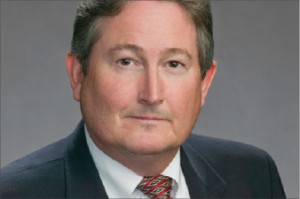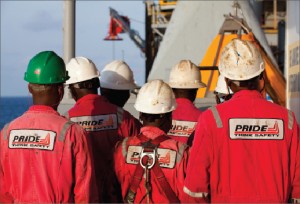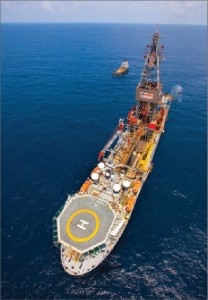Refocusing industry dialogue on reliability, fault management
Critical issues in drilling & completions with Mark Diehl, VP – engineering, Pride International
By Linda Hsieh, managing editor

What are some of the most critical issues facing the drilling and completion industry in terms of technology?
I place them into two buckets: reliability and fault management. In today’s high-risk, high-cost environment, current equipment and control systems may not be delivering a sufficient level of reliability and efficient fault management. Our industry has grown rapidly in the past 10 years. A lot of the industry’s engineering and processes have a very short time frame in which to be implemented, and the industry must manage that.
The industry needs to continue placing emphasis on the reliability of materials, the robustness of designs, redundancy in control systems, and survivability. Investment in these types of engineering needs to stay abreast of the higher levels of risk and cost. This also implies a higher level of skills and base competencies for industry personnel – engineers, maintenance and operations people.
How is survivability applicable to our industry?
Often it is assumed that critical safety equipment or systems will operate during an incident. In some cases, a second, or backup, system is in place. In the process control industry, like on a production facility, they talk about survivability. If there is an incident, will this control system survive the incident such that it can retain its functions? Would a safety-critical system, like a BOP control system, survive an incident such that it can be used? If you decide that it won’t survive the incident, that may alter your appetite to take on that risk without additional redundancy. You may change your processes to avoid putting yourself in that position or redesign the system to survive.
Where does the responsibility for looking at these types of engineering fall?
There is a constant dialogue in the business between vendors, contractors and operators about what directions we need to go. However, over the last 10 years, with the fast pace of building equipment, these conversations may not have taken place as much as needed. The industry needs to refocus itself on that.
Is it because drilling equipment is getting so complicated that the importance of these kinds of engineering is rising as well?
There’s no doubt equipment is getting more complicated. Alarm management is a potential issue. There are so many bells and whistles for the driller to use on top of an extensive alarm system, it can become difficult to manage without proper training. The industry needs to understand and design in the logic that tells a driller what’s important, what’s failing, what’s not working, so the appropriate response can be made.
What are some new technologies or equipment Pride is looking at implementing to improve drilling efficiency?
We’ve introduced the new Vetco MR-6H SE riser, which works like an H4 connector with a cam ring that you have to lock down using a special spider. There are no bolts, no dogs to run in and no screws. It’s a simple latch. When we ran it on one of our new deepwater newbuilds for testing purposes, we were approaching five joints an hour, which is pretty fast in this day and age. It also removes people from directly making the connection so there is less risk.
On our new drillships we also installed 160-ton heave-compensated cranes for doing subsea installation work. It’s not new technology, but it’s new as applied to a drilling rig.
Additionally, we’re applying NOV’s PIM (pipe interlock management) in conjunction with zone management. With all those tools moving around the rig floor, you don’t want them running into each other. PIM monitors activities of drill floor machines to avoid unintended interaction.
Do drilling contractors continue to enhance the development capabilities of deepwater drilling rigs in response to operator requests?
Yes. Completion work in the deepwater is fairly complex. New rigs have dedicated systems for completion work and for drilling work. For example, we’ve increased the number of mud pits so we can provide a separate system that never sees drilling fluids.
Do you see that as the way forward for the design of deepwater drilling rigs?
Yes. It’s more efficient. When you’re hiring a rig for a long-term development program at deepwater spread rates, the client’s going to want a fully featured and efficient rig.
What have been some challenges you’ve faced deploying managed pressure drilling from a floating rig?

From a process point of view, well control is an important consideration. With dual gradients or managed pressure drilling, some conventional well control rules may not apply because you’re adjusting pressure on a fine line. It’s important to understand what the well is telling you and understand in advance how to manage a well control incident. Another challenge is the lack of a standard set of technology across the industry. Each customer may have their own idea about how to handle an issue. The equipment is one off, to some extent.
The equipment is also more complex on a floater versus a jackup. Operators may have experience with equipment like rotating heads, but on a floater when you have a slip joint, you need a reciprocating rotating head. That gets a little more complicated.
And because there is more equipment and more complexity, stack problems are harder to deal with. It may take several days to rig down all the managed pressure equipment before you can even get to your stack, so the reliability of your stack must be higher.
Managed pressure drilling is increasingly accepted as an enabling technology. What can drilling contractors do to make the implementation of this technology possible/economic on more wells? On the operator side, what can they do to help the uptake of MPD?
A few things could be done in the industry on the contractor side. First, where possible, build rigs with a bigger air gap, which may allow a longer telescopic joint stroke. Second, bigger moonpool spaces could accommodate managed pressure drilling choke manifold or other equipment. Third, have greater riser tensioning capacity. Some dual-gradient drilling requires concentric high-pressure riser, and that’s heavy stuff. If you’re going to run that in deepwater, you’ll need better riser tensioning capacity.
On the operator side, it would be to coalesce around standard technical solutions. Typically the solutions that have been offered out there were field-specific. Each operator developed them according to their specific needs, and that makes it hard for a drilling contractor who’s trying to respond to everybody. As an industry, establishing standards would help enable technology to deliver on its promise.
In light of the Macondo blowout, operators are working on improving technologies related to oil spill response and cleanup for deepwater. On the drilling contractor side, what improvements are needed on drilling rigs to ensure safe deepwater drilling, in terms of technology and people/training?
I refer to my previous comment about improved reliability and fault management. In addition to equipment, I think the industry could focus more on people and training. When you look at an event like Macondo, it can be broken down into equipment, people and processes. A lot of the focus has been on equipment, but not much has been said about the people and the management processes.
A full understanding by all personnel, both on and off the rig, of all the risks inherent in the well construction activity is necessary. There should be a process to ensure that such risks are communicated and understood and that controls are in place to manage them. This requires a high level of engagement between the operator and the contractor that must begin during the well planning phase and continue into the well construction phase.
Offshore environments and conditions are not static. People constantly evaluate changes so they can gauge the effect of risk controls and mitigations that were put in place.
Will this require a longer lead time before deepwater wells can be spud?

Yes. It’s an engagement process. These deepwater programs are long-term projects. Operators hire a rig like our new drillships for five-year contracts. Engagement should occur in advance so that the contractor and service companies understand how the well is designed. What is the casing design basis? Why are the casing points set in this zone? Once operators design the well, all parties need to understand how those construction activities have to be conducted in order to manage the risks of the well.
There has been a massive expansion of drilling activity the last 10 years, and people tend to focus on work in silos. The drilling contractor focuses on keeping equipment running and making a hole. The operator focuses on designing casing, getting a permit and delivering the consumables to the well site. The industry needs to work together, rather than focusing on individual parts.
It seems the new regulations in the Gulf will go toward helping to break those silos down.
The Well Construction Interface Document submitted by industry to the BOEMRE will be a way for the operator, contractor and service company to jointly understand the activity that they’re about to undertake.
Do you think that more training is needed specifically for deepwater?
I think it’s all types of training, but it’s also more than training. It’s a deeper competency to fully understand a process and then perform it. I think the industry could improve processes and further develop activity sets. Do operators fully understand all the risk involved in drilling the well? What new risk does the well present? Each activity set has its own set of risks, and the industry’s practice needs to make sure that all people understand those risks and the processes used to manage those risks.
To me, training is not a big enough word.
Is Pride working to redefine these processes?
Yes, and the industry is, too. We’re always encouraging more dialogue with our clients to understand their well construction activity.
The industry needs an across-the-board appreciation and understanding that these conversations are necessary and a joint view of the risks.
On your newbuilds, what have been the challenges with regards to getting equipment to perform as they are designed?
One focus is to maintain a robust commissioning and system integration testing program in a fast-paced construction climate. You build a rig in 18 to 24 months. Shipyards build rigs; they don’t operate rigs. We’re the ones who have to operate it. The focus is to ensure the equipment is commissioned properly and that it’s functioning as designed, all within the build cycle.
Within this build cycle, it’s necessary to quickly incorporate lessons learned. You learn something on one rig and incorporate it on another rig.
Should contractors build in more time at the shipyard for systems integration testing?
It takes careful planning. When you look at how systems are commissioned and how integration tests are done, it’s like building a pyramid. If you do the first course of bricks right, then the next one is easier. I think we have to continue to invest significant time to plan the commissioning and integration testing program.
Does the top drive remain the top cause of downtime on your rigs? What is being done to improve the maintenance of top drives?
That’s still a major cause, but in the deepwater it’s also about the subsea BOP stack. There’s been a lot of attention paid to improving top drive performance with much more proactive maintenance practices. The vendors have been really quick to learn, too. When we’re having a problem, they want to understand it quickly. They’ll go back to their design board and think it through, and they may come out with a modification or improvement.
What should industry focus on to improve the subsea BOP stack? The repair and maintenance process, reliability or the overall design?
The industry should focus on each stage. The materials we use, the reliability of the materials, the reliability of the control systems and components, the maintenance practices used. The industry should focus on project planning between-well movements of the stack and the work involved. I know that API has been thinking about this too. API RP 53, which speaks to stack maintenance activities, is being rewritten. The RP will move from being a recommended practice to being a standard.
Although the drilling moratorium in the Gulf of Mexico has been officially lifted, the market is still effectively frozen as of early 2011. What do you think might be some long-term impacts for deepwater E&P in this region?
Rigs, people and capital may leave the US Gulf. In addition, there could be a downsizing of the infrastructure to support E&P activity. This would make the production of the future much more expensive. When operators are looking at capital choices and they see uncertainty in the Gulf of Mexico, they may put their money elsewhere. When that happens, everything else – the rigs and the people – will go where the money is.
You believe that rigs, people and capital will leave the Gulf of Mexico?
Capital doesn’t sit there on the shelf. Will an operator put their money in an uncertain place where they don’t even know if they can get a drilling permit?
How long do you think it will take the Gulf of Mexico to go back to pre-Macondo activities – if ever?
That’s a political question. In the current political climate, it may be unlikely that we have a comparable return of activity.
How are you addressing concerns from clients in regions outside the Gulf of Mexico who need reassurance that you can continue to drill deepwater wells safely?
Several clients outside the Gulf have latched on to NTL 05. They want to apply all or part of it, but there are no clear steps on how to implement.
Does Pride have a strategy in place for getting all the necessary third-party inspections and certifications of your equipment required in the new BOEMRE rules? What are the major challenges?
Our maintenance has always been above standards, but one area in which regulations have an impact is documentation. A lot more questions are asked about the maintenance, the history of the stack equipment and any changes made to the BOP stack. It focuses a lot more attention on the documentation.
It would also be helpful going forward for the BOEMRE to establish more standards and issue guidance on certification requirements.
What changes in day-to-day operations will be required due to the new BOEMRE regulations?
I think the biggest change is going to be the MOC for the operator. It will be a much more detailed process for the operator going forward. For the contractor, the focus will be having real-time documentation for all BOP systems.
There’s also language in the new regulations about sending real-time data from the rig’s equipment to shore. When implemented, that could create technical challenges.
Has Macondo changed the level of risk the industry faces?
It’s not that the risk has changed; it’s how people have responded to the risk, how they manage risk, how they think about risk. If you have an extension cord you’re walking over everyday, one day you might trip over it. Why don’t we rearrange the extension cord? The industry needs to manage its risk sufficiently. Just throwing money at something is not going to improve it. The industry needs to fundamentally alter its management of risk.
